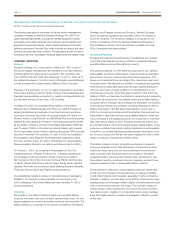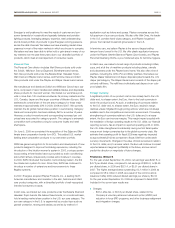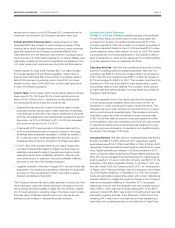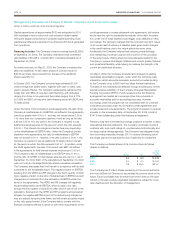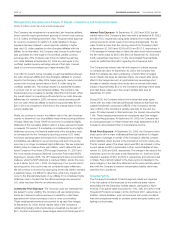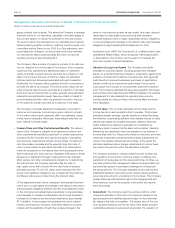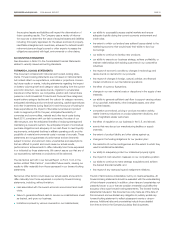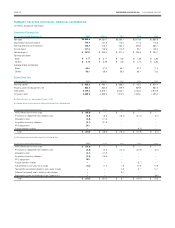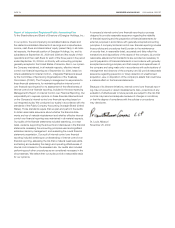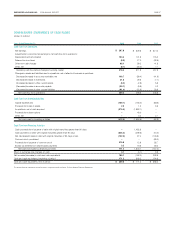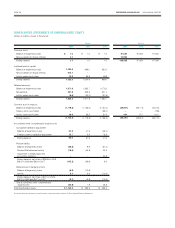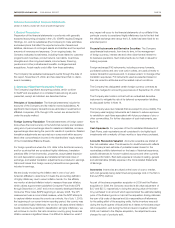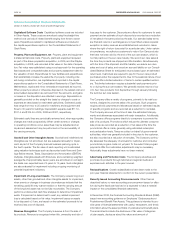Energizer 2009 Annual Report Download - page 22
Download and view the complete annual report
Please find page 22 of the 2009 Energizer annual report below. You can navigate through the pages in the report by either clicking on the pages listed below, or by using the keyword search tool below to find specific information within the annual report.
Management’s Discussion and Analysis of Results of Operations and Financial Condition
(Dollars in millions, except per share and percentage data)
PAGE 20 ENERGIZER HOLDINGS INC. 2009 ANNUAL REPORT
gauge potential returns issues. This allows the Company to manage
shipment activity to our customers, especially in the latter stages of
the sun care season, to reduce the potential for returned product.
The level of returns may fluctuate from our estimates due to several
factors including weather conditions, customer inventory levels, and
competitive activity. Based on our 2009 Sun Care shipments, each
percentage point change in our returns rate would have impacted
our reported net sales by approximately $2.8 and our reported
operating income by approximately $2.5.
The Company offers a variety of programs, primarily to its retail cus-
tomers, designed to promote sales of its products. Such programs
require periodic payments and allowances based on estimated
results of specific programs and are recorded as a reduction to net
sales. The Company accrues, at the time of sale, the estimated
total payments and allowances associated with each transaction.
Additionally, the Company offers programs directly to consumers to
promote the sale of its products. Promotions which reduce the ulti-
mate consumer sale prices are recorded as a reduction of net sales
at the time the promotional offer is made, generally using estimated
redemption and participation levels. Taxes we collect on behalf of
governmental authorities, which are generally included in the price
to the customer, are also recorded as a reduction of net sales.
The Company continually assesses the adequacy of accruals for
customer and consumer promotional program costs not yet paid.
To the extent total program payments differ from estimates, adjust-
ments may be necessary. Historically, these adjustments have not
been material to annual results.
■ Pension Plans and Other Postretirement Benefits The determi-
nation of the Company’s obligation and expense for pension and
other postretirement benefits is dependent on certain assumptions
developed by the Company and used by actuaries in calculating
such amounts. Assumptions include, among others, the discount
rate, future salary increases and the expected long-term rate of
return on plan assets. Actual results that differ from assumptions
made are recognized on the balance sheet and subsequently amor-
tized to earnings over future periods. Significant differences in actual
experience or significant changes in assumptions may materially
affect pension and other postretirement obligations. In determining
the discount rate, the Company generally uses the yield on
high-quality bonds that coincide with the cash flows of its plans’
estimated payouts. For the U.S. plans, which represent the Com-
pany’s most significant obligations, we consider both the CitiGroup
and Mercer yield curves in determining the discount rates.
Of the assumptions listed above, changes in the expected long-term
rate of return on plan assets and changes in the discount rate used in
developing plan obligations will likely have the most significant impact
on the Company’s annual earnings prospectively. A one percentage
point decrease or increase in actual asset returns would decrease or
increase the Company’s pre-tax pension expense by approximately
$7. In addition, it may increase and accelerate the rate of required
pension contributions in the future. Uncertainty related to economic
markets and the availability of credit may produce changes in the
yields on corporate bonds rated as high-quality. As a result, discount
rates based on high-quality corporate bonds may increase or
decrease leading to lower or higher, respectively, pension obligations.
A one percentage point decrease in the discount rate would increase
obligations by approximately $80 at September 30, 2009.
As allowed under GAAP, the Company’s U.S. qualified pension plan
uses Market Related Value, which recognizes market appreciation
or depreciation in the portfolio over five years so it reduces the
short-term impact of market fluctuations.
■ Valuation of Long-Lived Assets The Company periodically
evaluates its long-lived assets, including goodwill and intangible
assets, for potential impairment indicators. Judgments regarding the
existence of impairment indicators, including lower than expected
cash flows from acquired businesses, are based on legal factors,
market conditions and operational performance. Future events
could cause the Company to conclude that impairment indicators
exist. The Company estimates fair value using valuation techniques
such as discounted cash flows and EBITDA multiples. This requires
management to make assumptions regarding future income,
working capital and discount rates, which would affect the impair-
ment calculation.
■ Income Taxes The Company estimates income taxes and the
income tax rate in each jurisdiction that it operates. This involves
estimating taxable earnings, specific taxable and deductible items,
the likelihood of generating sufficient future taxable income to utilize
deferred tax assets and possible exposures related to future tax
audits. Deferred tax assets are evaluated on a subsidiary by
subsidiary basis to ensure that the asset will be realized. Valuation
allowances are established when the realization is not deemed to
be more likely than not. Future performance is monitored, and when
objectively measurable operating trends change, adjustments are
made to the valuation allowances accordingly. To the extent the
estimates described above change, adjustments to income taxes
are made in the period in which the estimate is changed.
The Company operates in multiple jurisdictions with complex tax
and regulatory environments, which are subject to differing inter-
pretations by the taxpayer and the taxing authorities. At times, we
may take positions that management believes are supportable, but
are potentially subject to successful challenges by the appropri-
ate taxing authority. The Company evaluates its tax positions and
establishes liabilities in accordance with recently issued guidance
governing accounting for uncertainty in income taxes. The Company
reviews these tax uncertainties in light of the changing facts and
circumstances, such as the progress of tax audits, and adjusts
them accordingly.
■ Acquisitions The Company uses the purchase method, which
requires the allocation of the cost of an acquired business to the
assets acquired and liabilities assumed based on their estimated
fair values at the date of acquisition. The excess value of the cost
of an acquired business over the fair value of the assets acquired
and liabilities assumed is recognized as goodwill. The valuation of


